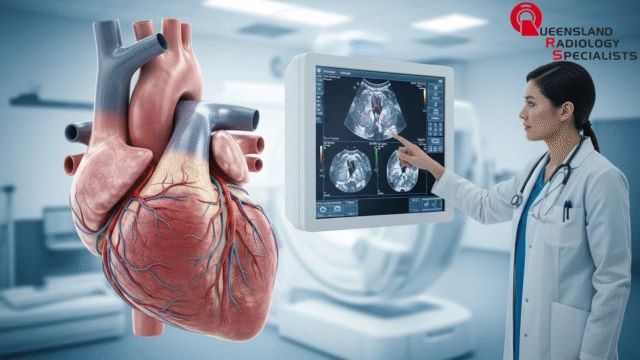
CT Coronary Angiography is a medical imaging technique that uses advanced computed tomography to create detailed pictures of the heart’s blood vessels. It provides clear, three-dimensional images that help doctors evaluate coronary artery health and detect blockages or narrowing that may lead to heart problems.
This test plays an important role in modern cardiac care by offering a non-invasive alternative to traditional catheter-based angiography, reducing patient risk and recovery time.
Features of CT Coronary Angiography
CT Coronary Angiography combines precision imaging with advanced computer processing to provide a comprehensive view of the coronary arteries. The main features include:
| Feature | Description |
|---|---|
| Non-invasive imaging | Uses a CT scanner and intravenous contrast dye rather than surgical catheter insertion. |
| High-resolution images | Captures detailed 3D images of the heart’s arteries. |
| Fast scan times | Produces results in minutes, reducing discomfort and examination time. |
| Low radiation dose options | Modern scanners minimise radiation exposure while maintaining quality. |
| Functional assessment | Identifies not just blockages, but also plaque build-up and vessel condition. |
How CT Coronary Angiography Works
To perform CT Coronary Angiography, a contrast dye is injected into a vein, usually in the arm. The dye highlights blood flow within the coronary arteries. A CT scanner then takes multiple cross-sectional images in rapid succession. Advanced software reconstructs these slices into a 3D image, allowing the cardiologist to examine the arteries from different angles.
This process identifies narrowing caused by plaque deposits, congenital artery anomalies, and other structural issues affecting blood supply to the heart muscle.
Use Cases in Heart Health
CT Coronary Angiography is applied in multiple cardiac scenarios. Some examples include:
| Use Case | Example |
|---|---|
| Chest pain investigation | A patient with unexplained chest discomfort undergoes imaging to rule out coronary artery disease. |
| Pre-surgical assessment | Before valve surgery, a scan confirms whether coronary arteries are clear. |
| Risk evaluation | A person with a family history of heart disease is assessed for early signs of blockage. |
| Monitoring post-treatment | After stent placement, imaging ensures proper blood flow is restored. |
| Anomaly detection | Identifies rare artery formations or birth defects affecting circulation. |
Pros and Cons of CT Coronary Angiography
Every medical test has benefits and limitations. Understanding both helps patients make informed decisions.
| Pros | Cons |
|---|---|
| Non-invasive procedure | Requires contrast dye, which may cause allergic reactions in rare cases |
| Produces detailed 3D images | May not be suitable for people with irregular heart rhythms |
| Short scanning time | Exposure to low-dose radiation |
| Detects plaque build-up and vessel condition | Not always conclusive for very small vessel disease |
| Can rule out coronary artery disease quickly | May require follow-up invasive angiography if results are unclear |
Who Benefits Most from CT Coronary Angiography
CT Coronary Angiography suits patients who need clear information about the state of their coronary arteries without undergoing invasive surgery. Groups that benefit most include:
- Individuals with moderate risk of heart disease, such as those with high cholesterol or hypertension.
- Patients experiencing atypical chest pain where other tests have been inconclusive.
- People with a strong family history of early heart disease.
- Those requiring a pre-operative assessment before non-cardiac surgeries.
- Individuals who have undergone previous treatments like bypass surgery or stent placement and need monitoring.
Situational Relevance in Cardiac Care
In busy emergency departments, CT Coronary Angiography can quickly rule out acute coronary syndromes in patients with low-to-intermediate risk. In outpatient cardiology clinics, it helps plan preventive strategies for patients showing early signs of artery narrowing.
For rural or regional Australian health services, its fast turnaround reduces the need for patients to travel to metropolitan hospitals for invasive procedures.
Comparison with Traditional Coronary Angiography
| Attribute | CT Coronary Angiography | Traditional Coronary Angiography |
|---|---|---|
| Invasiveness | Non-invasive | Invasive (catheter insertion) |
| Recovery time | Immediate return to normal activities | Several hours to a day |
| Image detail | High-resolution 3D | High-resolution 2D |
| Risks | Low | Higher due to catheterisation |
| Suitability | Screening and diagnosis | Detailed treatment planning and interventions |
Patient Experience During the Procedure
During the scan, the patient lies on a CT table. ECG leads are attached to monitor heart rhythm, and the contrast dye is injected through an IV line. The scanning process usually takes less than 10 minutes.
The patient may be asked to hold their breath for short intervals to prevent image blurring. Most patients resume normal activities immediately after leaving the imaging centre.
Reducing Risks and Ensuring Safety
Safety is a priority in any imaging test. CT Coronary Angiography uses modern equipment with low-dose radiation protocols. Allergic reactions to contrast dye occur in fewer than 1% of cases, and pre-screening helps identify high-risk individuals.
For people with kidney issues, doctors may recommend alternative imaging methods or additional hydration before and after the procedure.
The Role in Preventive Heart Care
Heart disease remains one of Australia’s leading causes of death, accounting for about 42,000 hospitalisations annually. CT Coronary Angiography helps identify disease before symptoms become severe, enabling early lifestyle changes and medical interventions.
By detecting plaque build-up and vessel narrowing early, patients can start targeted treatments, such as cholesterol-lowering medication or dietary adjustments, to slow disease progression.
visit: https://www.qldradiologyspecialists.com.au/radiology_services/ct-coronary-angiography/
Final Thoughts
CT Coronary Angiography is a powerful diagnostic tool that combines advanced imaging with minimal patient discomfort. It serves as an effective method for evaluating coronary artery health, guiding treatment decisions, and supporting preventive care strategies.
With its ability to provide fast, accurate, and non-invasive insights into the heart’s condition, it plays a crucial role in modern cardiology and contributes to better heart health outcomes for Australians.






